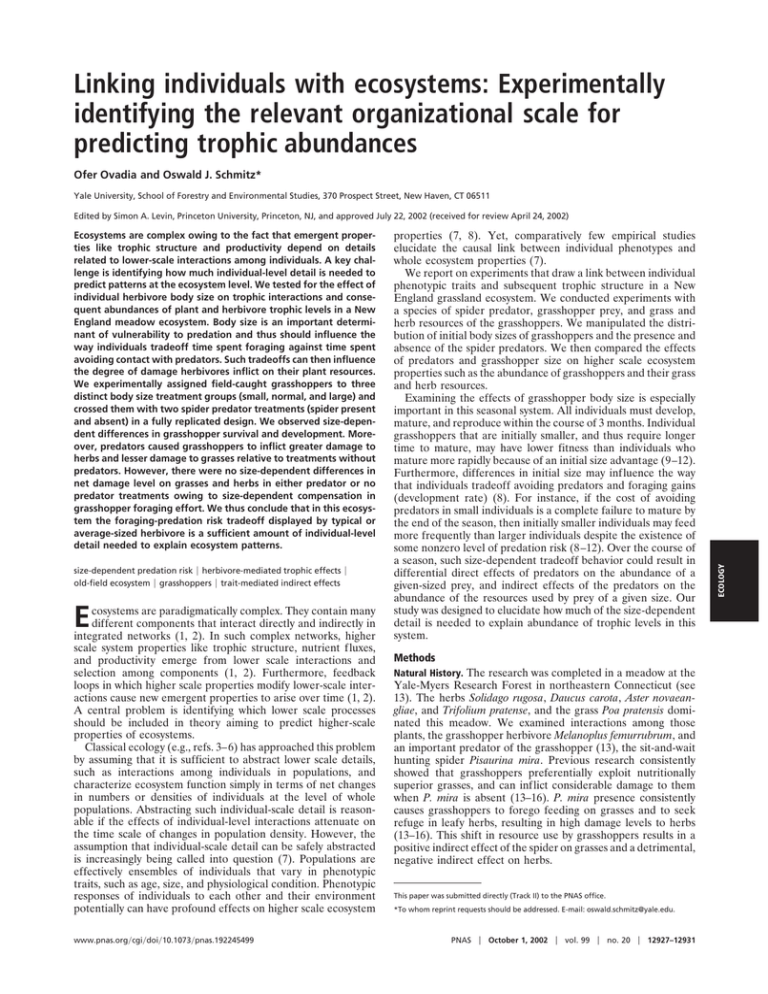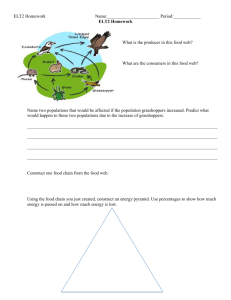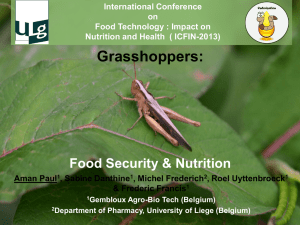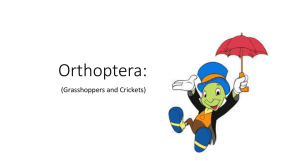Linking individuals with ecosystems: Experimentally identifying the relevant organizational scale for
advertisement

Linking individuals with ecosystems: Experimentally identifying the relevant organizational scale for predicting trophic abundances Ofer Ovadia and Oswald J. Schmitz* Yale University, School of Forestry and Environmental Studies, 370 Prospect Street, New Haven, CT 06511 Ecosystems are complex owing to the fact that emergent properties like trophic structure and productivity depend on details related to lower-scale interactions among individuals. A key challenge is identifying how much individual-level detail is needed to predict patterns at the ecosystem level. We tested for the effect of individual herbivore body size on trophic interactions and consequent abundances of plant and herbivore trophic levels in a New England meadow ecosystem. Body size is an important determinant of vulnerability to predation and thus should influence the way individuals tradeoff time spent foraging against time spent avoiding contact with predators. Such tradeoffs can then influence the degree of damage herbivores inflict on their plant resources. We experimentally assigned field-caught grasshoppers to three distinct body size treatment groups (small, normal, and large) and crossed them with two spider predator treatments (spider present and absent) in a fully replicated design. We observed size-dependent differences in grasshopper survival and development. Moreover, predators caused grasshoppers to inflict greater damage to herbs and lesser damage to grasses relative to treatments without predators. However, there were no size-dependent differences in net damage level on grasses and herbs in either predator or no predator treatments owing to size-dependent compensation in grasshopper foraging effort. We thus conclude that in this ecosystem the foraging-predation risk tradeoff displayed by typical or average-sized herbivore is a sufficient amount of individual-level detail needed to explain ecosystem patterns. size-dependent predation risk 兩 herbivore-mediated trophic effects 兩 old-field ecosystem 兩 grasshoppers 兩 trait-mediated indirect effects E cosystems are paradigmatically complex. They contain many different components that interact directly and indirectly in integrated networks (1, 2). In such complex networks, higher scale system properties like trophic structure, nutrient fluxes, and productivity emerge from lower scale interactions and selection among components (1, 2). Furthermore, feedback loops in which higher scale properties modify lower-scale interactions cause new emergent properties to arise over time (1, 2). A central problem is identifying which lower scale processes should be included in theory aiming to predict higher-scale properties of ecosystems. Classical ecology (e.g., refs. 3–6) has approached this problem by assuming that it is sufficient to abstract lower scale details, such as interactions among individuals in populations, and characterize ecosystem function simply in terms of net changes in numbers or densities of individuals at the level of whole populations. Abstracting such individual-scale detail is reasonable if the effects of individual-level interactions attenuate on the time scale of changes in population density. However, the assumption that individual-scale detail can be safely abstracted is increasingly being called into question (7). Populations are effectively ensembles of individuals that vary in phenotypic traits, such as age, size, and physiological condition. Phenotypic responses of individuals to each other and their environment potentially can have profound effects on higher scale ecosystem www.pnas.org兾cgi兾doi兾10.1073兾pnas.192245499 properties (7, 8). Yet, comparatively few empirical studies elucidate the causal link between individual phenotypes and whole ecosystem properties (7). We report on experiments that draw a link between individual phenotypic traits and subsequent trophic structure in a New England grassland ecosystem. We conducted experiments with a species of spider predator, grasshopper prey, and grass and herb resources of the grasshoppers. We manipulated the distribution of initial body sizes of grasshoppers and the presence and absence of the spider predators. We then compared the effects of predators and grasshopper size on higher scale ecosystem properties such as the abundance of grasshoppers and their grass and herb resources. Examining the effects of grasshopper body size is especially important in this seasonal system. All individuals must develop, mature, and reproduce within the course of 3 months. Individual grasshoppers that are initially smaller, and thus require longer time to mature, may have lower fitness than individuals who mature more rapidly because of an initial size advantage (9–12). Furthermore, differences in initial size may influence the way that individuals tradeoff avoiding predators and foraging gains (development rate) (8). For instance, if the cost of avoiding predators in small individuals is a complete failure to mature by the end of the season, then initially smaller individuals may feed more frequently than larger individuals despite the existence of some nonzero level of predation risk (8–12). Over the course of a season, such size-dependent tradeoff behavior could result in differential direct effects of predators on the abundance of a given-sized prey, and indirect effects of the predators on the abundance of the resources used by prey of a given size. Our study was designed to elucidate how much of the size-dependent detail is needed to explain abundance of trophic levels in this system. Methods Natural History. The research was completed in a meadow at the Yale-Myers Research Forest in northeastern Connecticut (see 13). The herbs Solidago rugosa, Daucus carota, Aster novaeangliae, and Trifolium pratense, and the grass Poa pratensis dominated this meadow. We examined interactions among those plants, the grasshopper herbivore Melanoplus femurrubrum, and an important predator of the grasshopper (13), the sit-and-wait hunting spider Pisaurina mira. Previous research consistently showed that grasshoppers preferentially exploit nutritionally superior grasses, and can inflict considerable damage to them when P. mira is absent (13–16). P. mira presence consistently causes grasshoppers to forego feeding on grasses and to seek refuge in leafy herbs, resulting in high damage levels to herbs (13–16). This shift in resource use by grasshoppers results in a positive indirect effect of the spider on grasses and a detrimental, negative indirect effect on herbs. This paper was submitted directly (Track II) to the PNAS office. *To whom reprint requests should be addressed. E-mail: oswald.schmitz@yale.edu. PNAS 兩 October 1, 2002 兩 vol. 99 兩 no. 20 兩 12927–12931 ECOLOGY Edited by Simon A. Levin, Princeton University, Princeton, NJ, and approved July 22, 2002 (received for review April 24, 2002) Fig. 1. Frequency distribution of grasshopper body length (2nd-instar nymphs). This distribution was used to designate 3 size classes that were used in experiments in the laboratory and the field: large individuals, the uppermost 15% of the frequency distribution (body length ⬎ 12 mm); small individuals, the lowest 15% of the frequency distribution (body length ⬍ 9 mm); and average individuals, the middle portion of the frequency distribution (9 –12 mm). Study Design. The study was comprised of two complementary experiments. First, we conducted a bench-top experiment under semifield conditions to quantify the potential for size-selective predation of grasshoppers by the spiders. Second, we conducted an enclosure experiment in the field to quantify the direct and indirect effects of spiders on size-based grasshopper populations and the indirect effects of the predator on grass and herb resources, mediated by different-sized grasshoppers. In early July 2001, we sampled grasshoppers by using sweep nets and measured the length (head to end of abdomen) of individual grasshoppers. Previous research (15) indicated that body length in M. femurrubrum grasshoppers is negatively correlated with vulnerability to predation by P. mira spiders. We generated a frequency distribution of grasshopper body length (Fig. 1) and then designated 3 size classes based on this distribution: large individuals were those in the uppermost 15% of the frequency distribution (body length ⬎ 12 mm); small individuals were those in the lowest 15% of the frequency distribution (body length ⬍ 9 mm); and average individuals were those from the middle portion of the frequency distribution (9–12 mm). The average size class represented a benchmark to evaluate consistency between this and previous studies that also used a random sample of similar-sized individuals (13, 15). The bench-top experiment was conducted in July 2001 in 0.5 m2 ⫻ 1 m high screen terraria affixed to small benches. The benches were arrayed outdoors in a grid at the Yale-Myers research station such that each terrarium received similar exposure to natural sunlight and moisture. Each terrarium was filled with pieces of sod cut from the same fields in which we conducted the enclosure experiment. Each piece of sod was selected to ensure an approximately equal representation of grasses and forbs. The terraria were small enough to observe grasshoppers feeding, yet large enough to permit grasshopper movement to avoid contact with predators. The experiment was designed to measure short-term prey size selection by spiders. We stocked to the terraria 3 individual P. mira spiders and 4 small and 4 large M. femurrubrum grasshoppers. We used spiders that were large 12928 兩 www.pnas.org兾cgi兾doi兾10.1073兾pnas.192245499 enough (16–20 mm) to capture and subdue juvenile grasshoppers (7–18 mm). After 24 hours, we collected all grasshoppers in the terraria that remained alive and measured their body length. We conducted an enclosure experiment in the field to test for direct effects of spiders on experimental populations of grasshoppers and indirect effects of spiders on grass and herb resources. A positive indirect effect of predators on plants can be detected whenever predator addition to food webs results in lowered damage to plants (i.e., a net increase in plant biomass) relative to food webs containing only herbivores and plants. A negative indirect effect occurs whenever predator addition to food webs causes herbivores to inflict more damage to plants (i.e., a net decrease in plant biomass) than in food webs containing only herbivores and plants. The enclosure experiment in the field was conducted in standard aluminum screening enclosure cages measuring 0.25 m2 (basal area) ⫻ 1 m (height). The protocol for cage construction and placement in the field has been presented elsewhere (15). The cages were arrayed in a randomized-blocks design separated by 1.5 m and placed over natural vegetation in the field. This method of cage placement does not introduce bias in initial grass and herb composition in the cages (13). We removed all animals within the cages by carefully hand-sorting through the vegetation and litter in each cage. We removed all of the large insects and spiders from the cages. Small spider species could not be removed; although their size and habitat use prevented capture, it also precluded their ability to prey on the grasshoppers or the treatment spiders. The experiment consisted of six treatments and a control randomly assigned to each of 15 blocks. We assembled, in enclosure cages, experimental food webs composed of plants only (1-trophic level control), plants and grasshoppers assigned by size class (three different 2-trophic level treatments) and plants, grasshoppers assigned by size class, and a spider predator (three different 3-trophic level treatments). In early July 2001, we collected grasshoppers for the enclosure experiments using sweep nets. Individual grasshoppers were sorted into one of the three size classes (Fig. 1). At the same time, we collected P. mira spiders in the field by using sweep nets. We stocked each 2-level and 3-level treatment cage with 6 early-instar (2nd) grasshopper nymphs, which was about 1.5 times natural field densities at the time of stocking. Grasshoppers were intentionally stocked this way to produce a pulse perturbation that allowed their densities to decline toward levels set by local limiting factors in each cage (e.g., food resources, predators, etc.). In some cases, these local levels may be higher than the average density for the whole field (13, 15). At this time, we also stocked 1 spider predator to the 3-level treatment cages. Spiders stocked were large enough (16–20 mm) to capture and subdue all sizes of grasshopper prey (juveniles, 7–18 mm; adults, 19–24 mm). We conducted censuses of enclosure densities of grasshoppers and spiders over the course of the entire experiment. After initial stocking, the first three censuses were performed at 2-day intervals to ensure that grasshopper populations did not go extinct because of artifacts of initial conditions (none went extinct). Thereafter, enclosures were monitored every 5 days until termination of the experiment mid-September. Ten days before terminating the experiment, we used calipers to measure grasshopper body length during the course of a routine census. In such censuses, grasshoppers typically rise up on the screening and remain immobile long enough to measure body length. Length measurements were used to estimate growth rate and test whether the relative differences in size among classes remained consistent during the season. The enclosure experiment was run for the full generation time of the grasshoppers. It was terminated just before the seasonal onset of frosts that kill the arthropod community and cause the herbaceous plant community to senesce. At this time, all plants Ovadia and Schmitz in the enclosures were clipped to the soil surface, sorted by class (grass and herb), dried at 60°C for 48 h, and weighed. rately. We used Bonferroni t tests to identify treatments that were significantly different. Data Analysis. We tested for direct effects of P. mira on M. Results The prey size-selection trials revealed that ⬇3 of every 4 grasshoppers consumed by P. mira were in the small size class (Fig. 2). Such size-based differences in mortality are also reflected in survival probabilities estimates from caged populations in the field (Fig. 2). Specifically, survival of large and average grasshoppers was 2 times higher than small grasshoppers (Cox proportional hazard model, z ⫽ ⫺4.27, P ⬍ 0.001). Furthermore, this difference in survival probability between the small and larger size classes was consistent between the no predator and predator treatments (Cox proportional hazard model, predation ⫻ size treatment interaction, z ⫽ 0.88, P ⫽ 0.38, Fig. 2). Closer inspection of the survival trajectory revealed that the majority of predation effects occurred within the first 10 days of the experiment. By the end of the season, survival within each size class in no-predator treatments was similar to survival in predator treatments (Cox proportional hazard model, z ⫽ ⫺0.58, P ⫽ 0.56). Mean grasshopper density at the end of the experiment (Fig. 2) varied significantly with grasshopper size class (ANOVA, P ⬍ 0.001, df ⫽ 2, 70), but not with predator treatment (ANOVA, P ⬎ 0.65, df ⫽ 1, 70). There was no significant size ⫻ predator treatment interaction (ANOVA, P ⬎ 0.30, df ⫽ 2, 70), nor a significant block effect (ANOVA, P ⬎ 0.30, df ⫽ 14, 70). Bonferroni comparisons revealed that grasshopper densities in the large and average size class were not significantly different, femurrubrum grasshoppers in field enclosures in two ways. We conducted a survival analysis to compare the mortality rates of different size classes of grasshoppers in the presence and absence of spider by using the counting process notation of the Cox proportional hazard model (17). This method controls for repeated measurements on a subject, which, in our case, were individual cages that were repeatedly censused throughout the season. We also compared the end-of-season enclosure densities in size-structured 2-level webs (plants and grasshoppers) and size-structured 3-level webs (plants, grasshoppers, and spider) by using a randomized block ANOVA. This was followed by Bonferroni t tests to identify treatments that differed. We tested for treatment effects on late-season grasshopper body length by using randomized block ANOVA. We also tested for differences in body growth rate among size classes by comparing the proportional change in body length [(final size ⫺ initial size)兾initial size] by using randomized block ANOVA on arcsine-square root transformed data. These two ANOVAs were followed by Bonferroni t tests to identify treatments that differed. We tested for indirect effects of P. mira on plants by comparing biomass in 1-level food webs (plants only) with biomass in size-structured 2-level webs (plants and grasshoppers) and size-structured 3-level webs (plants, grasshoppers, and spider) by using randomized block ANOVAs for grasses and herbs sepaOvadia and Schmitz PNAS 兩 October 1, 2002 兩 vol. 99 兩 no. 20 兩 12929 ECOLOGY Fig. 2. The effect of body size and spider predator on survival and population demography of grasshoppers. (a) Results of behavioral trials demonstrating that spider predators can capture and subdue grasshoppers and that grasshoppers assigned to small size classes suffer significantly higher mortality than larger grasshoppers. (b) Field experiment data showing that mean grasshopper density at the end of season varies significantly with grasshopper size class but not with predator treatment. (c and d) Survival curves of grasshoppers within each of the size classes, in the presence (c) and absence (d) of spider predators, indicating that survival probability of large and average grasshoppers is significantly higher than that of small grasshoppers. Fig. 3. Change in grasshopper body length within each size class over the course of the season. (a) Initial and late season body length demonstrating consistent differences among all size classes. Lines indicate linear approximations of growth trajectories over the course of the season. (b) Mean proportional change in body length of grasshoppers showing that smaller size classes have higher growth rates than larger size classes. irrespective of predator presence or absence (Fig. 2). Densities of small grasshoppers were significantly lower than densities of the other two size classes (Fig. 2). Mean grasshopper length remained significantly different among size classes over the course of the season (ANOVA, P ⬍ 0.001, df ⫽ 2, 70). Bonferroni comparisons revealed that all size classes differed significantly from each other (Fig. 3). There was no significant predator effect (ANOVA, P ⫽ 0.978, df ⫽ 1, 70), nor a size ⫻ predator interaction (ANOVA, P ⬎ 0.807, df ⫽ 2, 70). Mean growth rate of grasshoppers (Fig. 3) varied significantly by body size class (ANOVA, P ⬍ 0.001, df ⫽ 2, 70). Bonferroni comparisons revealed that the mean growth rate of grasshoppers was significantly different among all size classes: smaller size classes had higher growth rates than larger size classes (Fig. 3). Growth rates were not affected by the addition of predators (ANOVA, P ⫽ 0.946, df ⫽ 1, 70), nor was there a growth rate ⫻ predator interaction (ANOVA, P ⫽ 0.855, df ⫽ 2, 70). At the food web level (Fig. 4), there was a significant treatment effect on the abundance of grasses (ANOVA, P ⬍ 0.001, df ⫽ 6, 84) and herbs (ANOVA, P ⬍ 0.001, df ⫽ 6, 84). Block effects were not significant in either analysis (both ANOVAs, P ⬎ 0.45, df ⫽ 14, 84). The Bonferroni comparisons revealed that in the absence of predators, grasshoppers caused a significant reduction in grass biomass, relative to the plant-only control (Fig. 4). The addition of predators caused a reduction in damage by grasshoppers to the extent that the abundance of grass in the presence of predators was not significantly different form the plant-only control (Fig. 4). In the absence of predators, all size classes of grasshoppers caused marginal reductions in herb biomass; only average grasshoppers had a significant effect (Fig. 4). The addition of predators caused all size classes of grasshoppers to inflict significantly high levels of damage to herbs 12930 兩 www.pnas.org兾cgi兾doi兾10.1073兾pnas.192245499 Fig. 4. Biomass of grass (a) and herb (b) plants in food webs of varying number of trophic levels. (a) In the absence of predators (2-trophic levels), grasshoppers caused a significant reduction in grass biomass, relative to the plant-only control (1-trophic level). The addition of predators (3-trophic levels) caused a reduction in damage inflicted by grasshoppers to the extent that the abundance of grass in the presence of predators was not significantly different form the plant-only control. There were no significant differences in damage level on grass among the size classes. (b) In the absence of predators, all size classes of grasshoppers caused marginal reductions in herb biomass. The addition of predators caused all size classes of grasshoppers to inflict significantly high levels of damage to herbs. There were no significant differences in damage level on herb among the size classes. (Fig. 4). Moreover, there were no significant differences in damage level among the size classes. Power analyses for all nonsignificant results reveled that the chance of committing a type II error with respect to the effect of size class (i.e., concluding that there was no body size effect when there really was) was on the order of 1–5%. Discussion This study was undertaken to examine how differences in a phenotypic trait among individuals in a population scale to net effects at the ecosystem level. We systematically assigned individuals in a grasshopper prey population to distinct trait (body size) classes that determine a grasshoppers’ vulnerability to hunting spider predators. We then tested for a size-dependent effect on the nature and strength of trophic interactions in experimentally assembled food webs in the field. Behavioral trials demonstrated that P. mira spiders can capture and subdue all size classes of M. femurrubrum grasshoppers and that grasshoppers assigned to small size classes (Fig. 1) suffered higher mortality than larger grasshoppers. This sizedependent mortality was also reflected in the survival trajectory in the experimental food webs. Within the first 10 days of the experiment, grasshoppers in predation treatments suffered higher mortality than grasshoppers in the no-predator control. However, the differential effects of predation attenuated over the course of the field experiment (Fig. 2), indicating that the net effects of predation were largely compensatory to natural mortality in the grasshopper population. This outcome is consistent with a series of independent studies using the same species at our study site (13–16) as well as in independent studies with grasshopper species at other geographic locations (18). Ovadia and Schmitz risk that small individuals with annual life cycles will fail to complete their development by the end of the season (10, 22). Our results are consistent with theoretical predictions (9, 11, 12) that initially smaller individuals may feed more frequently than larger individuals to sustain higher growth rates despite the existence of some nonzero level of starvation or predation risk. At the ecosystem level, we found that P. mira spiders had a significant positive indirect effect on abundance of grass resources and a significant negative indirect effect on abundance of herbs (Fig. 4), despite having little or no net direct effect on grasshopper density in any of the size classes by the end of the experiment. This outcome is consistent with expectations for indirect effects of predators on plants that are mediated entirely by changes in grasshopper foraging behavior to decrease predation risk (23). In the absence of predators, grasshoppers appear to preferentially exploit nutritionally superior grasses. P. mira presence caused grasshoppers to forego feeding on grasses and to seek refuge in leafy herbs, resulting in high damage levels to herbs. Thus, we can conclude from this experiment that individualscale behavioral details such as the predation risk-foraging tradeoff made by the prey has a direct link with the abundance of trophic levels. However, we found that finer-scale individual detail, such as variation in grasshopper body size, had little or no net effect in mediating the strength of the indirect effect of P. mira spiders on grasses and herbs. Thus, in this ecosystem, it would be sufficient to abstract the details associated with individual variation in trait (in this case body size) and simply represent the foraging–predation risk tradeoff displayed by individuals as a typical or average response to explain higher scale patterns in the abundance of trophic levels. This finding implies that we can obtain a tractable understanding of the link between lower-scale interactions among ecosystem components and higher scale ecosystem patterns. 1. Brown, J. H. (1995) in Linking Species and Ecosystems, eds. Jones, C. G. & Lawton, J. H. (Chapman & Hall, London), pp. 6–16. 2. Levin, S. A. (1998) Ecosystems 1, 431–436. 3. Rosenzweig, M. L. (1973) Am. Nat. 107, 275–294. 4. Oksanen, L., Fretwell, S. D., Arruda, J. & Niemelä, P. (1981) Am. Nat. 118, 240–262. 5. Carpenter, S. R., Kitchell, J. F. & Hodgson, J. R. (1986) Bioscience 35, 634–639. 6. Menge, B. A. & Sutherland, J. P. (1987) Am. Nat. 130, 730–757. 7. Agrawal, A. A. (2001) Science 294, 321–326. 8. Lima, S. L. (2002) Trends Ecol. Evol. 17, 70–75. 9. Abrams, P. A. & Rowe, L. (1996) Evolution (Lawrence, Kans.) 50, 1052–1061. 10. Rowe, L. & Ludwig, D. (1991) Ecology 72, 413–427. 11. Clark, C. W. & Mangel, M. (2000) Dynamic State Variable Models in Ecology (Oxford Univ. Press, Oxford). 12. Houston, A. I. & McNamara, J. M. (1999) Models of Adaptive Behaviour: An Approach Based on State (Cambridge Univ. Press, Cambridge, U.K.). 13. Schmitz, O. J. & Suttle, K. B. (2001) Ecology 82, 2072–2081. 14. Beckerman, A. P., Uriarte, M. & Schmitz, O. J. (1997) Proc. Natl. Acad. Sci. USA 94, 10735–10738. 15. Schmitz, O. J., Beckerman, A. P. & O’Brien, K. M. (1997) Ecology 78, 1388–1399. 16. Schmitz, O. J. & Sokol-Hessner, L. (2002) Ecol. Lett. 5, 168–172. 17. Andersen, P. K. & Gill, R. D. (1982) Ann. Stat. 10, 1100–1120. 18. Oedokoven, M. A. & Joern, A. (2000) Ecology 81, 66–77. 19. Belovsky, G. E. (1986) Am. Zool. 26, 51–69. 20. Beckerman, A. P. (2002) Oikos, in press. 21. Belovsky, G. E. & Slade, J. B. (1995) Oecologia 101, 383–396. 22. Ludwig, D. & Rowe, L. (1990) Am. Nat. 135, 686–707. 23. Schmitz, O. J. (1998) Am. Nat. 151, 327–342. Ovadia and Schmitz We thank M. Booth, C. Burns, J. Grear, and M. Young for help with the fieldwork. P. Abrams, M. Booth, C. Burns, J. Grear, L. Rowe, D. Skelly, and S. Stearns provided helpful comments and discussion. The research was supported by a Fulbright Postdoctoral Fellowship and a Gaylord Donnelley Environmental Fellowship (Yale Institution for Biospheric Studies, Yale University) (to O.O.) and by National Science Foundation Grant DEB-0107780 (to O.J.S.). PNAS 兩 October 1, 2002 兩 vol. 99 兩 no. 20 兩 12931 ECOLOGY Our field experiment did, however, demonstrate a net effect of grasshopper size on survival over the full course of the experiment. Grasshoppers assigned to the small size classes suffered higher mortality rates than grasshoppers assigned to larger size classes. Additionally, final densities of grasshoppers assigned to small size classes were significantly lower than grasshoppers assigned to the average and large size class, irrespective of predator presence or absence (Fig. 2). One possible cause of such a size effect is that small grasshoppers have a lower capacity to digest and assimilate much of the vegetation in the fields (19). Thus, smaller grasshoppers must spend considerable effort seeking high-quality plant resources that tend to be comparatively rare (19, 20). Experiments have revealed that this can lead to heightened starvation mortality of individuals in small size classes owing to greater intraspecific competition for food resources (20, 21). Despite the differences in final densities between small grasshoppers and the two other size classes, we detected little or no differences in the effect of grasshopper size class on the final abundance of grasses and herbs (Fig. 4). Inspection of the grasshopper growth rate data (Fig. 3) provides some clue about the mechanism producing this outcome. Grasshoppers in small size classes exhibited higher growth rates over the course of the season than did grasshoppers in the other two size classes. Such higher growth rates can only be sustained by higher foraging effort. Indeed, we estimated the expected relative impact of the different size classes on plants based on calculations of their cumulative impact over the season. We calculated the cumulative daily density of each size class in each cage for the entire season and, based on a conservative assumption that each individual in each size class has an equal per capita daily consumption rate, estimated the total damage that should have been inflicted on the plants by all individuals in the different size classes. We estimated that the impact of the small size class should be at least 40% weaker than that of the large size class. The observed absence of such a difference supports the assertion that individuals in the small size class fed more than individuals in larger size classes. As a consequence, the effect of lower density of smaller grasshoppers appeared to be compensated by greater per capita foraging effort of the surviving individuals. Such sizebased differences in effort are expected whenever there is a high



